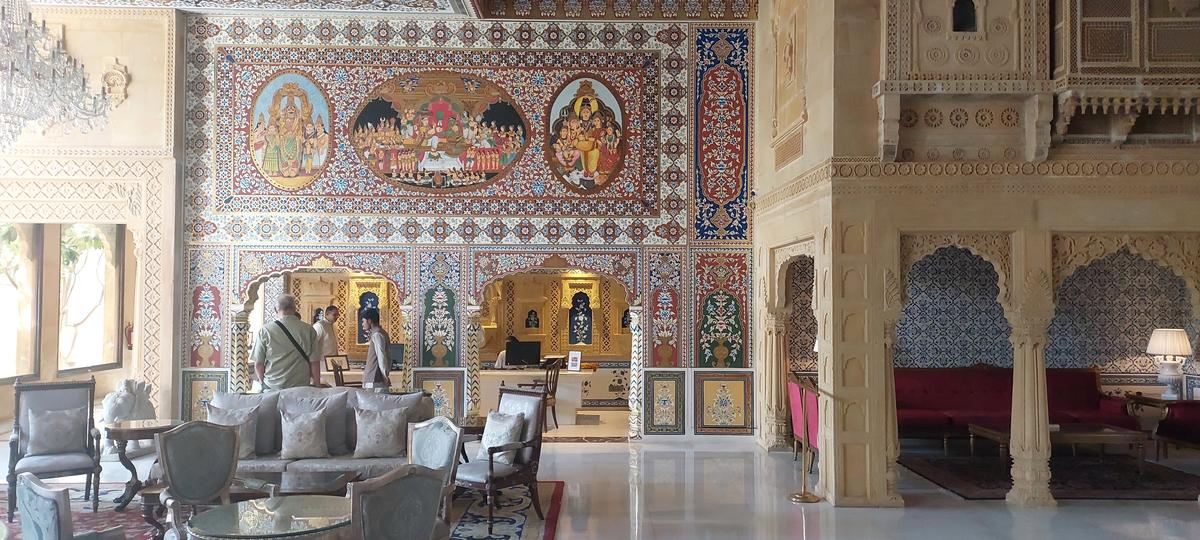Jaisalmer is arid and parched. Desert brush dot the sands that seem to stretch endlessly. In the city, the barrenness is equally pronounced, which makes the first glance of Fort Rajwada even more impressive.
The gates loom large and majestic and the driveway curves past green lawns to stop at ornate double doors, intricately carved in sterling silver. Once you step through them you travel back in time to the land of maharajas, flying carpets and caparisoned elephants.
Except, this fort has only been around for two decades.
Vinay Khosla, managing director, Fort Rajwada, explains, “This is a built fort, one among the few hotels of this size constructed in 1999, with an intent to replicate the historic forts of the region.” He adds that it changed hands in 2017, and once it came into their possession, they began upgrading it as a hotel.
First, there is the traditional welcome, complete with aarti, tikka and a garland of marigolds. Next, a warm towel materialises on a salver and honestly, it is a little hard to pay attention to these ministrations when the foyer is so captivating.
Every visible surface exudes opulence — chandeliers, lush carpets, elaborate wallpaper, plush upholstery and carved stone pillars. The inner doors, again sterling silver, open out into a courtyard walled off with turrets at each corner. A huge marble fountain is flanked by walkways and nooks to the different wings of the fort that house the rooms.
Fort Rajwada
| Photo Credit:
Ruth Dhanaraj
Each wing sports a different motif (rosette, geometric, and the like), which is mirrored throughout — from the accents on the room’s furniture to the smaller fountain in the centre of that wing. The attention to detail is astounding. Four poster beds, wood and rattan panelling, burnished brass fittings and cut glass lights, add to the continued feeling of stateliness.
Once you have settled in and shaken off your travel weariness, the hotel provides sightseeing trips into the city where one can marvel at its stunning historic architecture, and indulge in sampling local wares, arts and crafts.
Back at the Fort, arrangements are made for bonfires, folk singers and puppet shows in the evening for the entertainment of guests.
Indigenous materials
The overall colour scheme at the fort is gold, cream and beige, offset by warm wood and bright home decor.
“For the exteriors, Jaisalmer stone or sandstone indigenous to the region has been used; its hue is why we are called the Golden City. Inside, we’ve used Botticino and Red Levante, both Italian marble, while the lobby is done up in white Makrana, an exquisite white stone mined in Rajasthan,” says Vinay.
Though their wallpaper has been created by multiple award-winning designers, Vinay says the walls and ceiling of their reception area have been done by hand. “Artisans from various regions of our country, including Shekhawati, took about three years to complete their work in our hotel.”

Fort Rajwada
| Photo Credit:
Ruth Dhanaraj
A brightly-coloured 20×20 mural depicting scenes from The Ramayana dominates one wall of the foyer. “We believe these 35 frames showing different instances from the epic will help guests understand our festivals and the celebration of good over evil,” says Vinay.
With a room count of 99, the living spaces in Fort Rajwada have been designed to make guests feel at home. The Elephant and Monkey Lounges complete with well-stocked bookshelves, faux fireplace and antique Persian carpets (monogrammed by the craftsmen), give guests the freedom to socialise in an elegant sitting room.
Indian miniatures from the Company School — art done during the time of the East India Company, when European painters came to India with their techniques — line the corridors and a huge Tanjore work of art adorns the landing.
Past the first glance
“Service providers are also service receivers,” says Vinay, explaining how they updated the hotel. “Every product has a life cycle or a shelf life. If the same product is being stretched beyond its use it won’t make economic sense in the long run.”
According to Vinay, Fort Rajwada deploys sustainable methods for the upkeep of the hotel. “Stone paint has a limited commercial life, so for us to enhance longevity, various tools and equipment are used on a regular basis.”

Fort Rajwada
| Photo Credit:
Ruth Dhanaraj
Being a desert, almost every commodity in Rajasthan is hard to come by and is therefore more dearer than it would be elsewhere in the country. Thankfully, the Fort runs an effective rainwater harvesting and waste composting system. “With the hotel industry contributing to the world’s carbon emissions, it’s time for us to take sustainability measures and adopt more eco-friendly business practices,” says Vinay.
The writer was in Jaisalmer on the invitation of Fort Rajwada
Getting there
The best time to visit Jaisalmer is between October and March. As it is a defence airport, flights are limited but one can travel by road from Jodhpur in 4.5 hours. With well-paved roads sporting barely a pothole, even the most sensitive of car sick souls, will not have complaints.
Sightseeing in Jaisalmer
Jaisalmer Fort, Patwon Ki Haveli and the Jain Temples within the Fort are the main attractions. Many other edifices built using similar styles will captivate those with an interest in history and architecture.
Desert safaris and camel rides and camping will appeal to those willing to rough it out.
The Jaisalmer War Museum, Desert Culture Centre & Museum, Longewala War Memorial and Thar Heritage Museum beckon history buffs.
Gadisisar Sagar Lake, Kuldhara Abandoned Village, Akal Wood Fossil Park and Desert National Park are some other attractions apart from stores selling antique ware and handicrafts of the region.

Fort Rajwada
| Photo Credit:
Ruth Dhanaraj
Published – April 21, 2025 06:21 pm IST